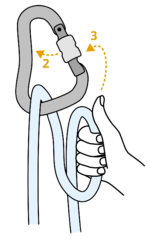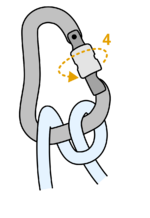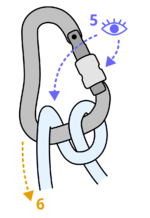Munter hitch/cs: Difference between revisions
Updating to match new version of source page |
Updating to match new version of source page |
||
| Line 9: | Line 9: | ||
</div> | </div> | ||
<div class="mw-translate-fuzzy"> | |||
Poloviční lodní smyčka je jedním ze základních uzlů. Je využívána pro jištění bez jistící pomůcky (např. ATC) pouze za pomocí lana a HMS karabiny. Je taktéž využívána v pokročilých lanových technikách (např. při záchranných pracech). | Poloviční lodní smyčka je jedním ze základních uzlů. Je využívána pro jištění bez jistící pomůcky (např. ATC) pouze za pomocí lana a HMS karabiny. Je taktéž využívána v pokročilých lanových technikách (např. při záchranných pracech). | ||
</div> | |||
<div lang="en" dir="ltr" class="mw-content-ltr"> | <div lang="en" dir="ltr" class="mw-content-ltr"> | ||
| Line 17: | Line 19: | ||
<div lang="en" dir="ltr" class="mw-content-ltr"> | <div lang="en" dir="ltr" class="mw-content-ltr"> | ||
=== Tying for an anchor belay (easy method) === | === Tying for an anchor belay (easy method) === | ||
This method is very robust and | This method is very robust and ideal for learning the Munter hitch. | ||
</div> | </div> | ||
<div lang="en" dir="ltr" class="mw-content-ltr"> | <div lang="en" dir="ltr" class="mw-content-ltr"> | ||
{{#invoke:FlexGallery|gallery | |||
|130px | |||
|File: Hms_ez_step1.png | |||
|Make a loop (1) | |||
|File: Hms_ez_step2.png | |||
|Pull your thumb through the loop (2) | |||
|File: Hms_ez_step3.png | |||
|Place another strand over your thumb and close the hand with your index finger (3) | |||
|File: Hms_ez_step4.png | |||
|Pull the carabiner through the rope exactly in the path of your thumb (4) | |||
|File: Hms_ez_step5.png | |||
|Screw the safety-lock (5) | |||
|File: Hms_ez_step6.png | |||
|Inspect that everything is correct (6) and as a final test, pull the brake strand (7), the Munter hitch flips into another Munter | |||
}} | |||
</div> | </div> | ||
<div lang="en" dir="ltr" class="mw-content-ltr"> | <div lang="en" dir="ltr" class="mw-content-ltr"> | ||
=== Tying for a harness belay === | === Tying for a harness belay === | ||
{{#invoke:FlexGallery|gallery | |||
|120px | |||
|File: Hms_harness_step0.png | |||
|Start with a rope through the carabiner which is attached to your harness | |||
|File: Hms_harness_step1.png | |||
|Take a bight of the rope (1) | |||
|File: Hms_harness_step2.png | |||
|Make a loop (2) | |||
|File: Hms_harness_step3.png | |||
|Open the carabiner gate (3) and seat the loop into the carabiner (4) | |||
|File: Hms_harness_step4.png | |||
|Screw the safety-lock (5) | |||
|File: Hms_harness_step5.png | |||
|Inspect that everything is correct (6) and pull the break-strand (7) to test if the munter hitch flips into another munter | |||
}} | |||
</div> | </div> | ||
<div lang="en" dir="ltr" class="mw-content-ltr"> | <div lang="en" dir="ltr" class="mw-content-ltr"> | ||
== Belaying == | == Belaying == | ||
Always hold the break strand! Belaying with Munter hitch is reliable and reasonably comfortable. | Always hold the break strand! Belaying with Munter hitch is reliable and reasonably comfortable. In works smoothly when not loaded, but provides plenty of friction to catch a fall once tensioned. It works at any angle of the brake strand. The main drawback is that if the rope is pulled through the hitch under load, it tends to tangle the rope, which is the main reason why it is now used only rarely. | ||
</div> | </div> | ||
<div lang="en" dir="ltr" class="mw-content-ltr"> | <div lang="en" dir="ltr" class="mw-content-ltr"> | ||
=== Belaying risks === | === Belaying risks === | ||
Belayer should keep their fingers at a respectful distance from the knot. Otherwise they might risk jamming the fingers into the belay, which might result in a severe finger injury.<ref>'''Warning - Gore''': {{cite web | url=https://rescue2training.com/tying-a-munter-hitch-around-an-object/ | title=Tying a Munter Hitch Around an Object (updated) | publisher=Rescue 2 Training | website=Rescue2Training.com | access-date=25 September 2025 | url-status=live | archive-url=https://web.archive.org/web/20250925045809/https://rescue2training.com/tying-a-munter-hitch-around-an-object/ | archive-date=25 September 2025}}</ref> Belayer should also ensure to tie the Munter in a way that it wont interfere with the carabiner gate/lock. Otherwise the rope friction might unlock, and maybe even open the carabiner gate. | |||
</div> | </div> | ||
<div lang="en" dir="ltr" class="mw-content-ltr"> | <div lang="en" dir="ltr" class="mw-content-ltr"> | ||
{{#invoke:FlexGallery|gallery_with_widths | |||
|File: Munter_fingers_safe.png | |||
|135px | |||
|When catching a fall, the rope slips a bit through the Munter. Keep your hand in a respectful distance from the hitch... | |||
|File: Munter_fingers.png | |||
|135px | |||
|... otherwise you risk jamming a finger | |||
|File:Hms_harness_step0.png | |||
|120px | |||
|If you plan to belay from the harness... | |||
|File: Hms belay with climber.png | |||
|120px | |||
|... tie the Munter in a way that it does not interfere with the carabiner gate/lock | |||
|File: hms_belay_left_bot.png | |||
|120px | |||
|Otherwise the rope friction might unlock... | |||
|File: hms_belay_left_top.png | |||
|120px | |||
|... or even open the carabiner during belaying | |||
}} | |||
</div> | </div> | ||
<div lang="en" dir="ltr" class="mw-content-ltr"> | <div lang="en" dir="ltr" class="mw-content-ltr"> | ||
== Tie-off - Mule overhand == | == Tie-off - Mule overhand == | ||
To set your hands free from belaying, tie-off the mule overhand. The tie-off consists from a slipknot followed by an overhand knot. Both of them are tied around the sharp end of the rope. The knot looks very tangled as both of these knots are tied with a bight and the rope is also pulled through the carabiner. It takes practice to reliably tie and inspect the tie-off. | |||
</div> | </div> | ||
<div lang="en" dir="ltr" class="mw-content-ltr"> | <div lang="en" dir="ltr" class="mw-content-ltr"> | ||
{{#invoke:FlexGallery|gallery_with_widths | |||
|File: hms_tieoff_step1_p6w.png | |||
|120px | |||
|If the knot is not in the correct position, flip the knot by giving a bit of a slack (1) | |||
|File: hms_tieoff_step2_p8w.png | |||
|160px | |||
|Make a loop (2) | |||
|File: hms_tieoff_step3_p8w.png | |||
|160px | |||
|Move it behind the sharp end of the rope (3) | |||
|File: hms_tieoff_step4_p8w.png | |||
|160px | |||
|Pull a bight of the rope belay end through the loop (4), making a slipknot around the sharp end | |||
|File: Munter_tieoff_step5.png | |||
|200px | |||
|Grab the bight with a hand (5) and simultaneously take slack out of the system while releasing the other hand (6), note that the break strand is still always being held during this step | |||
|File: hms_tieoff_step7_p8w.png | |||
|160px | |||
|Pull the bight through the carabiner (7), increase its size if necessary for the next steps | |||
|File: hms_tieoff_step8_p8w.png | |||
|160px | |||
|Secure the tie-off... | |||
|File: hms_tieoff_step9_p6w.png | |||
|120px | |||
|... by making an overhand around the life end of the rope (8,9) | |||
|File: hms_tieoff_step10_p6w.png | |||
|120px | |||
|And the mule-overhand tie-off is done | |||
}} | |||
</div> | </div> | ||
<div lang="en" dir="ltr" class="mw-content-ltr"> | <div lang="en" dir="ltr" class="mw-content-ltr"> | ||
| Line 97: | Line 136: | ||
Rychlá metoda pohybem jedné ruky. | Rychlá metoda pohybem jedné ruky. | ||
<div class="mw-translate-fuzzy"> | |||
[[File: Hms hand step1.png|150px]] | [[File: Hms hand step1.png|150px]] | ||
[[File: Hms hand step2.png|150px]] | [[File: Hms hand step2.png|150px]] | ||
[[File: Hms hand step3.png|150px]] | [[File: Hms hand step3.png|150px]] | ||
[[File: Hms hand step4.png|150px]] | [[File: Hms hand step4.png|150px]] | ||
</div> | |||
=== Podrobná metoda === | === Podrobná metoda === | ||
Podrobný návod krok za krokem. | Podrobný návod krok za krokem. | ||
<div class="mw-translate-fuzzy"> | |||
[[File: Munter_tie_step1.png|100px]] | [[File: Munter_tie_step1.png|100px]] | ||
[[File: Munter_tie_step2.png|100px]] | [[File: Munter_tie_step2.png|100px]] | ||
| Line 114: | Line 154: | ||
[[File: Munter_tie_step6.png|100px]] | [[File: Munter_tie_step6.png|100px]] | ||
[[File: Munter_tie_step7.png|100px]] | [[File: Munter_tie_step7.png|100px]] | ||
</div> | |||
<div lang="en" dir="ltr" class="mw-content-ltr"> | |||
== References == | |||
{{reflist}} | |||
</div> | |||
Revision as of 08:01, 25 September 2025
Poloviční lodní smyčka je jedním ze základních uzlů. Je využívána pro jištění bez jistící pomůcky (např. ATC) pouze za pomocí lana a HMS karabiny. Je taktéž využívána v pokročilých lanových technikách (např. při záchranných pracech).
Tying
Tying for an anchor belay (easy method)
This method is very robust and ideal for learning the Munter hitch.

Make a loop (1) 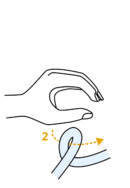
Pull your thumb through the loop (2) 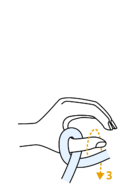
Place another strand over your thumb and close the hand with your index finger (3) 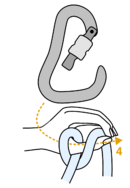
Pull the carabiner through the rope exactly in the path of your thumb (4) 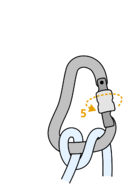
Screw the safety-lock (5) 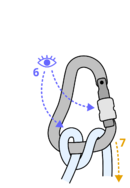
Inspect that everything is correct (6) and as a final test, pull the brake strand (7), the Munter hitch flips into another Munter
Tying for a harness belay

Start with a rope through the carabiner which is attached to your harness 
Take a bight of the rope (1) 
Make a loop (2) 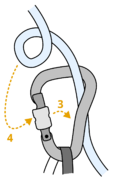
Open the carabiner gate (3) and seat the loop into the carabiner (4) 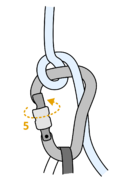
Screw the safety-lock (5) 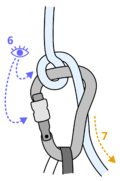
Inspect that everything is correct (6) and pull the break-strand (7) to test if the munter hitch flips into another munter
Belaying
Always hold the break strand! Belaying with Munter hitch is reliable and reasonably comfortable. In works smoothly when not loaded, but provides plenty of friction to catch a fall once tensioned. It works at any angle of the brake strand. The main drawback is that if the rope is pulled through the hitch under load, it tends to tangle the rope, which is the main reason why it is now used only rarely.
Belaying risks
Belayer should keep their fingers at a respectful distance from the knot. Otherwise they might risk jamming the fingers into the belay, which might result in a severe finger injury.[1] Belayer should also ensure to tie the Munter in a way that it wont interfere with the carabiner gate/lock. Otherwise the rope friction might unlock, and maybe even open the carabiner gate.
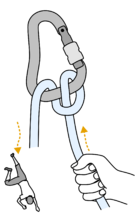
When catching a fall, the rope slips a bit through the Munter. Keep your hand in a respectful distance from the hitch... 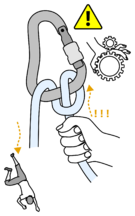
... otherwise you risk jamming a finger 
If you plan to belay from the harness... 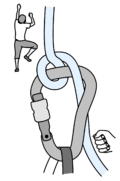
... tie the Munter in a way that it does not interfere with the carabiner gate/lock 
Otherwise the rope friction might unlock... 
... or even open the carabiner during belaying
Tie-off - Mule overhand
To set your hands free from belaying, tie-off the mule overhand. The tie-off consists from a slipknot followed by an overhand knot. Both of them are tied around the sharp end of the rope. The knot looks very tangled as both of these knots are tied with a bight and the rope is also pulled through the carabiner. It takes practice to reliably tie and inspect the tie-off.
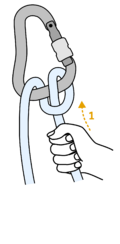
If the knot is not in the correct position, flip the knot by giving a bit of a slack (1) 
Make a loop (2) 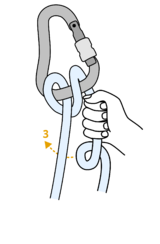
Move it behind the sharp end of the rope (3) 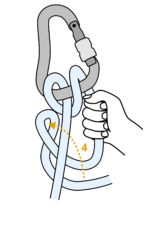
Pull a bight of the rope belay end through the loop (4), making a slipknot around the sharp end 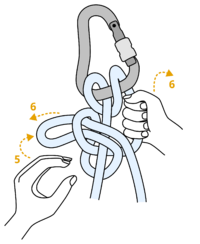
Grab the bight with a hand (5) and simultaneously take slack out of the system while releasing the other hand (6), note that the break strand is still always being held during this step 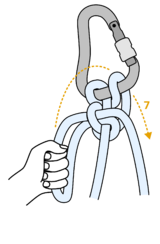
Pull the bight through the carabiner (7), increase its size if necessary for the next steps 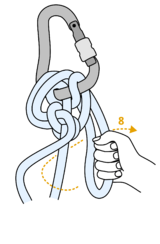
Secure the tie-off... 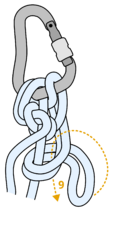
... by making an overhand around the life end of the rope (8,9) 
And the mule-overhand tie-off is done
Alternative tying methods
Metoda jednou rukou
Rychlá metoda pohybem jedné ruky.
Podrobná metoda
Podrobný návod krok za krokem.
File:Munter tie step1.png File:Munter tie step2.png File:Munter tie step3.png File:Munter tie step4.png File:Munter tie step5.png File:Munter tie step6.png File:Munter tie step7.png
References
- ↑ Warning - Gore: "Tying a Munter Hitch Around an Object (updated)". Rescue2Training.com. Rescue 2 Training. Archived from the original on 25 September 2025. Retrieved 25 September 2025.


